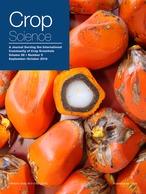Ver ítem
- xmlui.general.dspace_homeCentros Regionales y EEAsCentro Regional Santa FeEEA OliverosArtículos científicosxmlui.ArtifactBrowser.ItemViewer.trail
- Inicio
- Centros Regionales y EEAs
- Centro Regional Santa Fe
- EEA Oliveros
- Artículos científicos
- Ver ítem
Contrasting effects of phosphorus and potassium deficiencies on leaf area development in maize
Resumen
Management of P and K in agricultural systems is similar, since both move mainly by diffusion in soil. In maize (Zea mays L.), radiation capture is a consequence primarily of leaf area formation and senescence, but little is known about P and K interaction in determining both variables. The objective of this study was to assess the effects of P, K, and P × K interaction on (i) leaf appearance rate and final leaf number, (ii) individual leaf area, (iii)
[ver mas...]
Management of P and K in agricultural systems is similar, since both move mainly by diffusion in soil. In maize (Zea mays L.), radiation capture is a consequence primarily of leaf area formation and senescence, but little is known about P and K interaction in determining both variables. The objective of this study was to assess the effects of P, K, and P × K interaction on (i) leaf appearance rate and final leaf number, (ii) individual leaf area, (iii) leaf senescence rate, and (iv) leaf area development in maize. Two field experiments were performed in the 2011–2012 and 2012–2013 growing seasons, under no water and N limitations. Treatments consisted of different levels of P and K fertilization. Differential effects of both nutrients occurred for leaf area formation and senescence. Phosphorus deficiencies decreased average leaf appearance rate by 10% and individual leaf area by 18%, whereas K deficiency reduction of individual leaf area was 14%. Final leaf number did not change under both P and K deficiency. Phosphorus deficiencies decreased leaf senescence rate by 2%, whereas K deficiencies accelerated this process by 12%. As the result of the counteracting processes of expansion and senescence, P deficiency effects on green leaf area index were larger at the beginning of the crop cycle and tended to attenuate after, whereas K deficiencies were more important in later stages. These results may help in modeling the effects of P and K shortage in maize.
[Cerrar]

Autor
Arias Usandivaras, Luis María;
Gutierrez Boem, Flavio Hernán;
Salvagiotti, Fernando;
Fuente
Crop Science 58 (5) : 2099-2109 (2018)
Fecha
2018-10
Editorial
Crop Science Society of America
ISSN
0011-183X
1435-0653
1435-0653
Formato
pdf
Tipo de documento
artículo
Palabras Claves
Derechos de acceso
Restringido
 Excepto donde se diga explicitamente, este item se publica bajo la siguiente descripción: Creative Commons Attribution-NonCommercial-ShareAlike 2.5 Unported (CC BY-NC-SA 2.5)
Excepto donde se diga explicitamente, este item se publica bajo la siguiente descripción: Creative Commons Attribution-NonCommercial-ShareAlike 2.5 Unported (CC BY-NC-SA 2.5)

